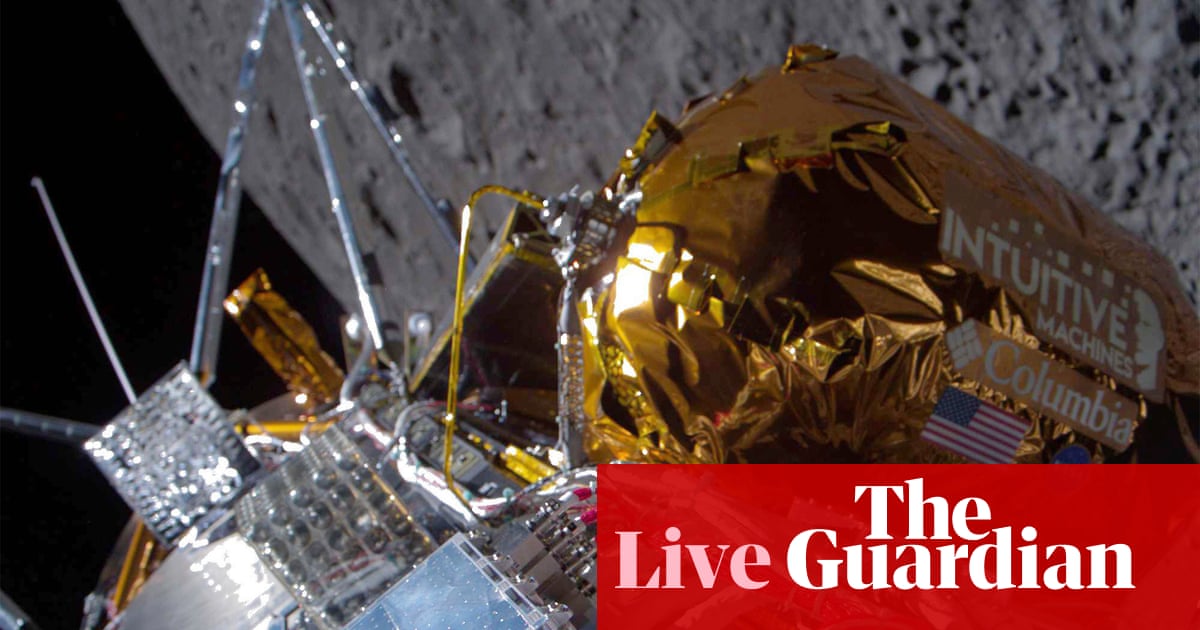The Odysseus is on the moon…
âWe are on the surface,â said Tim Crain, the chief technology officer who is leading mission control. âOdysseus has a new home.â
Key events
Flight controllers are still working on getting more information.
Nonetheless, it seems like Odysseus is the first American-built mission to land on the moon in more than a half century.
The Odysseus is on the moon…
âWe are on the surface,â said Tim Crain, the chief technology officer who is leading mission control. âOdysseus has a new home.â
It is possible that the Odysseus has crashed⦠or that thereâs a communication issue. Flight controllers are still trying to figure it out.
âWeâre not dead yet,â was the call out from mission control.
Weâre still standing by for confirmation. Controllers are going through the latest data that theyâve gotten from the lander. Thereâs possibly a communications glitch.
Weâve reached the expected time of landing⦠but waiting for confirmation.
The âhazard disturbance avoidanceâ process has begun. The lander is 1000m away from the surface.
The lander is making autonomous decisions about where to land. Weâre less than a minute away.
Odysseus lander close to touchdown
The mission director just called out three minutes till touchdown.
There will likely be a slight delay between when the lander makes contact with the surface, and when we will get confirmation. That delay could be as little as 15 seconds or several minutes.
A reminder that thereâs no human decisions being made about where to land. The autonomous system on the lander is scanning the surface for the best place to drop down.
The lander is feeding data to the scientists in the control room.
Everything seems on track so far, as the lander continues slowing itself down so that it can prepare for a vertical descent.
Odysseus in position to land
Odysseus has started its âpowered descent initiativeâ, as it readies for a landing. The engine on the lander has started up, and it is slowing itself down. As it lowers, sensors on the it will look for a safe spot for a landing,
What’s on board?

Martin Belam
As an example of the mixed payloads that private space missions are taking, Nasa administrator, Bill Nelson said of todayâs mission âNasa scientific instruments are on their way to the moon, a giant leap for humanity as we prepare to return to the lunar surface for the first time in more than half a century.â
He added âThese daring moon deliveries will not only conduct new science at the moon, but they are supporting a growing commercial space economy while showing the strength of American technology and innovation.â
But it isnât just science on board. There are also 125 of his miniature moon sculptures by the artis Jeff Koons. And as this social media post from Intuitive Machines shows, the lander is also carrying âan eternal tribute to His Holiness Pramukh Swami Maharajâ.
Created in coordination with Relative Dynamics, the IM-1 mission is flying an eternal tribute to His Holiness Pramukh Swami Maharaj, the fifth guru of the @BAPS Swaminarayan organization.
The etching honors the life and service of Pramukh Swami Maharaj, a Hindu spiritual leader⦠pic.twitter.com/4gEXthJykX
— Intuitive Machines (@Int_Machines) February 20, 2024

Martin Belam
Why isnât the landing a foregone conclusion? Well, âspace is hardâ as Nasa has tended to say. The recent track record of moon landing attempts is chequered to say the least.
Indiaâs Chandrayaan-3 mission made a historic landing on the south pole of the moon in August 2023, after a 40-day journey, and the rover had spent over a week collecting data from the lunar surface, but was powered down after a few days.
Japan became only the fifth nation to achieve a soft lunar landing, after the United States, the Soviet Union, China and India, when it deployed its Slim moon lander in January 2024. After an initial scare when it was thought the probe had landed in such a way that its solar panels wouldnât get enough light to power it, it began scientific operations.
The most recent US attempt to reach the moon ended in failure in January, when the spacecraft malfunctioned on the way to the moon and plunged back to Earth. That is gravity for you. A fuel leak onboard the Peregrine lander ended hopes it would reach the moon, despite a successful launch by the Vulcan Centaur rocket.
The Israeli Beresheet probe was meant to be the first private lander to touch down on the moon back in 2019, but it only succeeded in hitting the moon at sufficient speed that it may have spilled tardigrades on to the surface.

Ian Sample
Why does it seem to be harder to successfully land on the moon these days than it used to be? Our science editor Ian Sample explains:
One fundamental challenge, says Jan Wörner, a former director general of the European Space Agency (Esa), is weight. âYou are always close to failure because you have to be light or the spacecraft will not fly. You cannot have a big safety margin.â
Added to that, almost every spacecraft is a prototype. Apart from rare cases, such as the Galileo communications satellites, spacecraft are bespoke machines. They are not mass produced with the same tried and tested systems and designs. And once they are deployed in space, they are on their own. âIf you have trouble with your car, you can have it repaired, but in space thereâs no opportunity,â says Wörner. âSpace is a different dimension.â
The moon itself presents its own problems. There is gravity â one-sixth as strong as on Earth â but no atmosphere. Unlike Mars, where spacecraft can fly to their destination and brake with parachutes, moon landings depend entirely on engines. If you have a single engine, as smaller probes tend to, it must be steerable, because there is no other way to control the descent.
To complicate matters, the engine must have a throttle, allowing the thrust to be dialled up and down. âUsually you ignite them and they provide a steady state thrust,â says Nico Dettmann, Esaâs lunar exploration group leader. âTo change the thrust during operations adds a lot more complexity.â
Odysseus will use backup Lidar instrument during descent
Rather than using its own laser instrument as planned to guide its decent to the Moonâs surface, the Odysseus will instead use a Lidar instrument provided by Nasa.
The landerâs extra orbit around the moon, which delayed its descent today, allowed for controllers up update software to allow for the use of the Nasa instrument.

Ian Sample
For years space exploration have been a state enterprise, but a new program from Nasa has opened the doors to private enterprise. Todayâs landing attempt is one of a fleet of private spacecraft bound for the moon in the next few years. Under Nasaâs commercial lunar payload services (CLPS) initiative, the agency is funding firms to build spacecraft and deliver cargo â along with payloads from other paying organisations â to various sites on the lunar surface.
The arrangement is a way to ferry equipment to the moon before astronauts return there later this decade. But this new era of moon missions has some scientists rattled. Future landers aim to drill for ice and other materials, potentially iron and rare earths, which are of interest to mining firms, but might do damage to sites of scientific interest, or interfere with scientific experiements on the moon that rely on its isolation and contamination free environment.
The problem is that no one is coordinating plans. And as more landers touch down, and more companies invest, it will become harder to thrash out a fair and trusted process whereby all countries and all sectors can pursue their aims without messing things up for others.
Richard Luscombe
The uncrewed Nova-C lander built by Intuitive Machines launched on 15 February. Its scheduled touchdown near the moonâs south pole would be the first lunar landing of a US spacecraft since Nasaâs final Apollo mission in December 1972, and the first by a non-government entity.
âThere have been a lot of sleepless nights getting ready for this,â Steve Altemus, the co-founder and chief executive of Intuitive Machines, said in an interview before the mission. Altemus was formerly Nasaâs director of engineering and deputy director of the Johnson Space Center before founding his company of about 90 employees in 2013.
The lander is a 14ft (4.3 meter) hexagon-shaped craft with six legs, and is aimed towards a landing at crater Malapert A close to the lunar south pole. Odysseus is carrying a payload of six Nasa science instruments and technology demonstrations as part of the agencyâs commercial lunar payload services initiative
Intuitive Machines have been â in public â happy with the landerâs progress so far towards the moon.
It has successfully been sending images back to the Earth.
Intuitive Machines successfully transmitted its first IM-1 mission images to Earth on February 16, 2024. The images were captured shortly after separation from @SpaceX‘s second stage on Intuitive Machinesâ first journey to the Moon under @NASA‘s CLPS initiative. pic.twitter.com/9LccL6q5tF
— Intuitive Machines (@Int_Machines) February 17, 2024
Odysseus set for 6.24pm ET/11.24pm GMT landing
Maanvi Singh
The Odysseus is expected to land at 6.24pm ET/11.24pm GMT.
Intuitive Machines had initially said it would land at 5.49pm ET, then 5.30pm, and this morning said it could land even earlier at 4.24pm. But ultimately flight controllers decided to circle the Odysseus around the moon one more time before landing, delaying the event by two hours.
Intuitive Machines’ Odysseus aims to land on the moon
Welcome to the Guardianâs live coverage of the latest attempt to successfully soft-land the very first private lander on our closest neighbor â the moon!
Last week SpaceXâs Falcon rocket blasted off in the middle of the US night from Nasaâs Kennedy Space Center, dispatching Intuitive Machinesâ lunar lander on its 230,000 miles (370,000km) journey.
Today the Odysseus lander is attempting to make the perilous descent. Houston-based Intuitive Machinesâ aims to put its 14ft-tall, six-legged lander down just 186 miles (300km) shy of the moonâs south pole
Only five countries â the US, Russia, China, India and Japan â have scored a lunar landing and no private business has yet done so. The US has not returned to the moonâs surface since the Apollo program ended more than five decades ago.
Stay tuned for what could be a nerve-racking ride â¦







